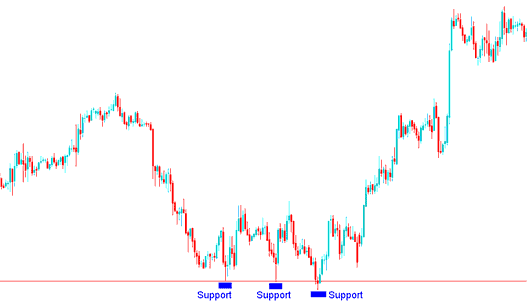Key Points for Setting Stop Losses
For indices stop orders, avoid tight spots. Place them away from support or resistance lines.
A few pips below the support or above the resistance areas is the best place.
When intending to enter a long position (purchase an asset), one should identify a proximate support level situated beneath the intended entry point and position the stop order approximately 10 to 20 pips below that support marker. The subsequent illustration clearly details the placement where a trader can set their protective stop orders just beneath the support benchmark on a stock chart.

Support Level for Putting Stop Loss Order Level for Buy Trade
If you are selling a financial instrument, find a nearby price level where the price has had trouble going higher, that is above where you started your trade, and put your stop loss about 10 to 20 pips above that level. The example given below shows where a trader can put their stop loss orders just above the price level on a stock chart.

Resistance Level for Placing Stop Loss Order Level for Sell Trade
Use Stop Loss Orders to Secure Profits, Not Just Cut Losses
A stop loss order means you don't have to watch the stock market every day. It's especially useful if you can't check your trades for a while, or, let's be honest, if you just want to get some sleep after a long day of trading.
A downside to stop-loss orders is the potential to trigger due to short-term price fluctuations. It's essential to set a stop-loss percentage that accommodates daily price movements while managing downside risks effectively.
Stock orders like these aim to limit losses, hence the name. They also secure gains, then called trailing stops.
For a trailing stop order it's put at a percentage level below the prevailing market price. This trailing level then shifted as the trade transaction position unfolds. Using a trailing stop loss level allows you to let profits run while at the same time ensures that should the stock trading market turn you will have locked in some of your profits.
These stock orders can also be used to lower risk if a trade starts making money. If a trade makes a lot of profit, the stop-loss order can be moved to the break-even point, which is where you started buying. This makes sure that even if the trade goes against you, you won't lose any money, and you will break even on that trade.
Trailing stop orders are used to make the most money and protect it when the stock price goes up, and to limit losses when it goes down.
A prime illustration involves employing the Parabolic SAR Stock Indicator and systematically advancing your stop order to align with the current Parabolic SAR level.

Utilizing the Parabolic SAR Technical Indicator for Setting Trailing Stop-Loss Orders in Index Trading
Another example is where a trader moves his stop loss by a specific number of pips after every few hours or after every 1 hour or after every 15 min depending on the chart time frame that the Stock Index trader is using.
In the stock trading example mentioned earlier, the parabolic SAR, set at 2 and 0.02, was employed as the trailing stop loss order for the chart above. The trader would have continuously adjusted the trailing stop loss level upwards after each SAR was indicated until the Parabolic SAR Indicator was triggered and the trend reversed.
Conclusion A stop order is a simple trading tool, yet so many investors fail to use it. Whether it's used to prevent excessive losses or to lock in trading profits, nearly all trading styles can benefit from this trading tool.
Factors To Remember When Setting These Stop Loss Orders
Remember these important things:
- Be careful with the points where you set these stop-losses. If indices normally fluctuates 20 points, you don't want to set your stoploss order too close to that range else you'll be taken out by the normal market volatility
- StopLoss Orders take the emotion out of a trading decisions & by setting one you set preset point of exiting a losing trade, intended to control losses.
- Traders can always use indicators to calculate where to put these levels, or use the concepts of Resistance & Support to decide where to set these stop loss orders. Another good technical indicator used to set these stop loss order orders is the Bollinger bands where traders use the upper & lower band as the limits of stock price therefore putting these orders outside the bands.
Check Out Extra Subjects and Lessons:

